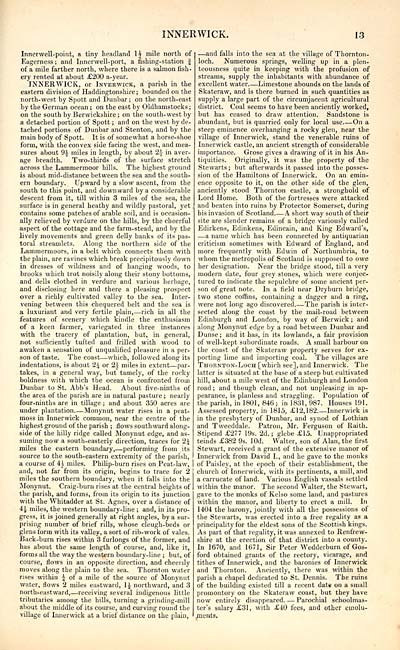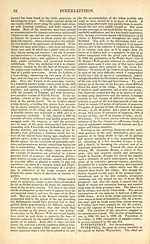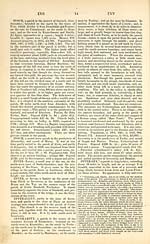Download files
Complete book:
Individual page:
Thumbnail gallery: Grid view | List view

INNERWICK.
13
Innerwell-point, a tiny headland 1A mile north of
Eagerness ; and Innerwell-port, a fishing-station J
of a mile farther north, where there is a salmon fish-
ery rented at about £200 a-year.
INNERWICK, or Inverwick, a parish in the
eastern division of Haddingtonshire; bounded on the
north-west by Spott and Dunbar ; on the north-east
by the German ocean ; on the east by Oldhamstocks ;
on the south by Berwickshire ; on the south-west by
a detached portion of Spott ; and on the west by de-
tached portions of Dunbar and Stenton, and by the
main body of Spott. It is of somewhat a horse-shoe
form, with the convex side facing the west, and mea-
sures about 9J miles in length, by about 2J in aver-
age breadth. Two-thirds of the surface stretch
across the Lammennoor hills. The highest ground
is about mid-distance between the sea and the south-
ern boundary. Upward by a slow ascent, from the
south to this point, and downward by a considerable
descent from it, till within 3 miles of the sea, the
surface is in general heathy and wildly pastoral, yet
contains some patches of arable soil, and is occasion-
ally relieved by verdure on the hills, by the cheerful
aspect of the cottage and the farm-stead, and by the
lively movements and green delly banks of its pas-
toral streamlets. Along the northern side of the
Lammermoors, in a belt which connects them with
the plain, are ravines which break precipitously down
in dresses of wildness and of hanging woods, to
brooks which trot noisily along their stony bottoms,
and dells clothed in verdure and various herbage,
and disclosing here and there a pleasing prospect
over a richly cultivated valley to the sea. Inter-
vening between this chequered belt and the sea is
a luxuriant and very fertile plain, — rich in all the
features of scenery which kindle the enthusiasm
of a keen farmer, variegated in three instances
with the tracery of plantation, but, in general,
not sufficiently tufted and frilled with wood to
awaken a sensation of unqualified pleasure in a per-
son of taste. The coast — which, followed along its
indentations, is about 2\ or 2k miles in extent — par-
takes, in a general way, but tamely, of the rocky
boldness with which the ocean is confronted from
Dunbar to St. Abb's Head. About five-ninths of
the area of the parish are in natural pasture ; nearly
four-ninths are in tillage ; and about 350 acres are
under plantation. — Monynut water rises in a peat-
moss in Innerwick common, near the centre of the
highest ground of the parish ; flows southward along-
side of the hilly ridge called Monynut edge, and as-
suming now a south-easterly direction, traces for 2\
miles the eastern boundary, — performing from its
source to the south-eastern extremity of the parish,
a course of ii miles. Philip-burn rises on Peat-law,
and, not far from its origin, begins to trace for 2
miles the southern boundary, when it falls into the
Monynut. Craig-burn rises at the central heights of
the parish, and forms, from its origin to its junction
with the Whitadder at St. Agnes, over a distance of
4-i miles, the western boundary-line ; and, in its pro-
gress, it is joined generally at right angles, by a sur-
prising number of brief rills, whose cleugh-beds or
glens form with its valley, a sort of rib- work of vales.
Back-burn rises within 3 furlongs of the former, and
has about the same length of course, and, like it,
forms all the way the western boundary-line ; but, of
course, flows in an opposite direction, and cheerily
moves along the plain to the sea. Thornton water
rises within j of a mile of the source of Monynut
water, flows 2 miles eastward, li northward, and 3
north-eastward, — receiving several indigenous little
tributaries among the hills, turning a grinding-mill
about the middle of its course, and curving round the
village of Innerwick at a brief distance on the plain,
— and falls into the sea at the village of Thornton-
loch. Numerous springs, welling up in a plen-
teousness quite in keeping with the profusion of
streams, supply the inhabitants with abundance of
excellent water. — Limestone abounds on the lands of
Skateraw, and is there burned in such quantities as
supply a large part of the circumjacent agricultural
district. Coal seems to have been anciently worked,
but has ceased to draw attention. Sandstone is
abundant, but is quarried only for local use On a
steep eminence overhanging a rocky glen, near the
village of Innerwick, stand the venerable ruins of
Innerwick castle, an ancient strength of considerable
importance. Grose gives a drawing of it in his An-
tiquities. Originally, it was the property of the
Stewarts; but afterwards it passed into the posses-
sion of the Hamiltons of Innerwick. On an emin-
ence opposite to it, on the other side of the glen,
anciently stood Thornton castle, a stronghold of
Lord Home. Both of the fortresses were attacked
and beaten into ruins by Protector Somerset, during
his invasion of Scotland A short way south of their
site are slender remains of a bridge variously called
Edirkens, Edinkens, Edincain, and King Edward's,
— a name which has been connected by antiquarian
criticism sometimes with Edward of England, and
more frequently with Edwin of Northumbria, to
whom the metropolis of Scotland is supposed to owe
her designation. Near the bridge stood, till a very
modern date, four grey stones, which were conjec-
tured to indicate the sepulchre of some ancient per-
son of great note. In a field near Dryburn bridge,
two stone coffins, containing a dagger and a ring,
were not long ago discovered The parish is inter-
sected along the coast by the mail-road between
Edinburgh and London, by way of Berwick ; and
along Monynut edge by a road between Dunbar and
Dunse; and it has, in its lowlands, a fair provision
of well-kept subordinate roads. A small harbour on
the coast of the Skateraw property serves for ex-
porting lime and importing coal. The villages are
Thobnton-Loch [which see], and Innerwick. The
latter is situated at the base of a steep but cultivated
hill, about a mile west of the Edinburgh and London
road ; and though clean, and not unpleasing in ap-
pearance, is planless and straggling. Population of
the parish, in 1801, 846 ; in 1831, 987. Houses 191.
Assessed property, in 1815, £12,182 Innerwick is
in the presbytery of Dunbar, and synod of Lothian
and Tweeddale. Patron, Mr. Ferguson of Raith.
Stipend £277 19s. 2d. ; glebe £15. Unappropriated
teinds £382 9s. lOd. Walter, son of Alan, the first
Stewart, received a grant of the extensive manor of
Innerwick from David I., and he gave to the monks
of Paisley, at the epoch of their establishment, the
church of Innerwick, with its pertinents, a mill, and
a carrucate of land. Various English vassals settled
within the manor. The second Walter, the Stewart,
gave to the monks of Kelso some land, and pastures
within the manor, and liberty to erect a mill. In
1404 the barony, jointly with all the possessions of
the Stewarts, was erected into a free regality as a
principality for the eldest sons of the Scottish kings.
As part of that regality, it was annexed to Renfrew-
shire at the erection of that district into a county.
In 1670, and 1671, Sir Peter Wedderburn of Gos-
ford obtained grants of the rectory, vicarage, and
tithes of Innerwick, and the baronies of Innerwick
and Thornton. Anciently, there was within the
parish a chapel dedicated to St. Dennis. The ruins
of the building existed till a recent date on a small
promontory on the Skateraw coast, but they have
now entirely disappeared. — Parochial schoolmas-
ter's salary £31, with £40 fees, and other emolu-
ments.
13
Innerwell-point, a tiny headland 1A mile north of
Eagerness ; and Innerwell-port, a fishing-station J
of a mile farther north, where there is a salmon fish-
ery rented at about £200 a-year.
INNERWICK, or Inverwick, a parish in the
eastern division of Haddingtonshire; bounded on the
north-west by Spott and Dunbar ; on the north-east
by the German ocean ; on the east by Oldhamstocks ;
on the south by Berwickshire ; on the south-west by
a detached portion of Spott ; and on the west by de-
tached portions of Dunbar and Stenton, and by the
main body of Spott. It is of somewhat a horse-shoe
form, with the convex side facing the west, and mea-
sures about 9J miles in length, by about 2J in aver-
age breadth. Two-thirds of the surface stretch
across the Lammennoor hills. The highest ground
is about mid-distance between the sea and the south-
ern boundary. Upward by a slow ascent, from the
south to this point, and downward by a considerable
descent from it, till within 3 miles of the sea, the
surface is in general heathy and wildly pastoral, yet
contains some patches of arable soil, and is occasion-
ally relieved by verdure on the hills, by the cheerful
aspect of the cottage and the farm-stead, and by the
lively movements and green delly banks of its pas-
toral streamlets. Along the northern side of the
Lammermoors, in a belt which connects them with
the plain, are ravines which break precipitously down
in dresses of wildness and of hanging woods, to
brooks which trot noisily along their stony bottoms,
and dells clothed in verdure and various herbage,
and disclosing here and there a pleasing prospect
over a richly cultivated valley to the sea. Inter-
vening between this chequered belt and the sea is
a luxuriant and very fertile plain, — rich in all the
features of scenery which kindle the enthusiasm
of a keen farmer, variegated in three instances
with the tracery of plantation, but, in general,
not sufficiently tufted and frilled with wood to
awaken a sensation of unqualified pleasure in a per-
son of taste. The coast — which, followed along its
indentations, is about 2\ or 2k miles in extent — par-
takes, in a general way, but tamely, of the rocky
boldness with which the ocean is confronted from
Dunbar to St. Abb's Head. About five-ninths of
the area of the parish are in natural pasture ; nearly
four-ninths are in tillage ; and about 350 acres are
under plantation. — Monynut water rises in a peat-
moss in Innerwick common, near the centre of the
highest ground of the parish ; flows southward along-
side of the hilly ridge called Monynut edge, and as-
suming now a south-easterly direction, traces for 2\
miles the eastern boundary, — performing from its
source to the south-eastern extremity of the parish,
a course of ii miles. Philip-burn rises on Peat-law,
and, not far from its origin, begins to trace for 2
miles the southern boundary, when it falls into the
Monynut. Craig-burn rises at the central heights of
the parish, and forms, from its origin to its junction
with the Whitadder at St. Agnes, over a distance of
4-i miles, the western boundary-line ; and, in its pro-
gress, it is joined generally at right angles, by a sur-
prising number of brief rills, whose cleugh-beds or
glens form with its valley, a sort of rib- work of vales.
Back-burn rises within 3 furlongs of the former, and
has about the same length of course, and, like it,
forms all the way the western boundary-line ; but, of
course, flows in an opposite direction, and cheerily
moves along the plain to the sea. Thornton water
rises within j of a mile of the source of Monynut
water, flows 2 miles eastward, li northward, and 3
north-eastward, — receiving several indigenous little
tributaries among the hills, turning a grinding-mill
about the middle of its course, and curving round the
village of Innerwick at a brief distance on the plain,
— and falls into the sea at the village of Thornton-
loch. Numerous springs, welling up in a plen-
teousness quite in keeping with the profusion of
streams, supply the inhabitants with abundance of
excellent water. — Limestone abounds on the lands of
Skateraw, and is there burned in such quantities as
supply a large part of the circumjacent agricultural
district. Coal seems to have been anciently worked,
but has ceased to draw attention. Sandstone is
abundant, but is quarried only for local use On a
steep eminence overhanging a rocky glen, near the
village of Innerwick, stand the venerable ruins of
Innerwick castle, an ancient strength of considerable
importance. Grose gives a drawing of it in his An-
tiquities. Originally, it was the property of the
Stewarts; but afterwards it passed into the posses-
sion of the Hamiltons of Innerwick. On an emin-
ence opposite to it, on the other side of the glen,
anciently stood Thornton castle, a stronghold of
Lord Home. Both of the fortresses were attacked
and beaten into ruins by Protector Somerset, during
his invasion of Scotland A short way south of their
site are slender remains of a bridge variously called
Edirkens, Edinkens, Edincain, and King Edward's,
— a name which has been connected by antiquarian
criticism sometimes with Edward of England, and
more frequently with Edwin of Northumbria, to
whom the metropolis of Scotland is supposed to owe
her designation. Near the bridge stood, till a very
modern date, four grey stones, which were conjec-
tured to indicate the sepulchre of some ancient per-
son of great note. In a field near Dryburn bridge,
two stone coffins, containing a dagger and a ring,
were not long ago discovered The parish is inter-
sected along the coast by the mail-road between
Edinburgh and London, by way of Berwick ; and
along Monynut edge by a road between Dunbar and
Dunse; and it has, in its lowlands, a fair provision
of well-kept subordinate roads. A small harbour on
the coast of the Skateraw property serves for ex-
porting lime and importing coal. The villages are
Thobnton-Loch [which see], and Innerwick. The
latter is situated at the base of a steep but cultivated
hill, about a mile west of the Edinburgh and London
road ; and though clean, and not unpleasing in ap-
pearance, is planless and straggling. Population of
the parish, in 1801, 846 ; in 1831, 987. Houses 191.
Assessed property, in 1815, £12,182 Innerwick is
in the presbytery of Dunbar, and synod of Lothian
and Tweeddale. Patron, Mr. Ferguson of Raith.
Stipend £277 19s. 2d. ; glebe £15. Unappropriated
teinds £382 9s. lOd. Walter, son of Alan, the first
Stewart, received a grant of the extensive manor of
Innerwick from David I., and he gave to the monks
of Paisley, at the epoch of their establishment, the
church of Innerwick, with its pertinents, a mill, and
a carrucate of land. Various English vassals settled
within the manor. The second Walter, the Stewart,
gave to the monks of Kelso some land, and pastures
within the manor, and liberty to erect a mill. In
1404 the barony, jointly with all the possessions of
the Stewarts, was erected into a free regality as a
principality for the eldest sons of the Scottish kings.
As part of that regality, it was annexed to Renfrew-
shire at the erection of that district into a county.
In 1670, and 1671, Sir Peter Wedderburn of Gos-
ford obtained grants of the rectory, vicarage, and
tithes of Innerwick, and the baronies of Innerwick
and Thornton. Anciently, there was within the
parish a chapel dedicated to St. Dennis. The ruins
of the building existed till a recent date on a small
promontory on the Skateraw coast, but they have
now entirely disappeared. — Parochial schoolmas-
ter's salary £31, with £40 fees, and other emolu-
ments.
Set display mode to: Large image | Transcription
Images and transcriptions on this page, including medium image downloads, may be used under the Creative Commons Attribution 4.0 International Licence unless otherwise stated. ![]()
| Gazetteers of Scotland, 1803-1901 > Topographical, statistical, and historical gazetteer of Scotland > Volume 2 > (23) Page 13 |
|---|
| Permanent URL | https://digital.nls.uk/97448866 |
|---|
| Description | Volume second: I-Z. |
|---|---|
| Shelfmark | Map Room Ref.2 |
| Attribution and copyright: |
|

